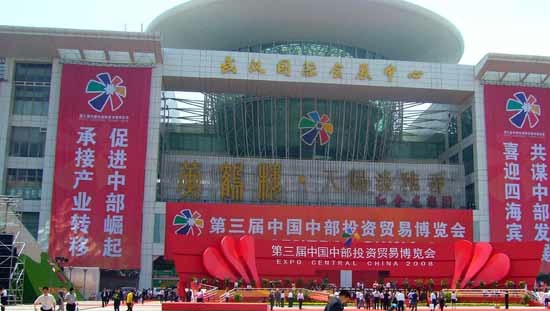Central China Expo promotes inbound investment

By Andy Scott
WUHAN, April 28 – Expo Central China 2008 came to a close today in the city of Wuhan, the provincial capital of Hubei province. The third of its kind, the expo is an opportunity for the Central China provinces of Anhui, Henan, Hubei, Hunan, Jiangxi and Shanxi to attract investor attention to a region that has historically lagged in development behind China’s coastal provinces.
As investor sentiment has waned for China’s coastal regions where the rising costs of doing business are beginning to force large corporations to rethink their China strategy, the Central China region, and especially Wuhan with its perfectly centered location in China, is looking to take advantage. Long considered a secondary market, the completion of the new, expanded Wuhan Tianhe International airport as well as the continued dredging of the Yangtze downriver is turning Wuhan into destination for foreign investment.
The expo’s theme focused on the region’s belief that industry inside China is indeed beginning to shift, and the main focus of many of the provincial officials at the expo was directing inbound investment from the coast. At the opening ceremony, Vice-Premier Wang Qishan stressed that the region needed further reform and opening-up, stressing awareness of reform, innovation, and the rule of law as keys.
Central China boasts some of the most connected cities on the mainland thanks to a well-developed rail network. The network integrates dozen of trunk lines and hundreds of branch lines, accounting for 23 percent of the national rail mileage. According to regional authorities, the rail network handles 36 percent of the nation’s passenger flow and 30 percent of the goods traffic.
The importance of the region as a crossroads for China was brought home earlier this year when much of South China up through Hubei and Henan provinces was brought to a standstill by severe winter storms that disrupted train schedules and brought down power grids, leaving millions stranded or without power. At the time this was viewed as a major test for the government, and at the expo, they sought to burnish their image, with a large hall specifically dedicated to the government’s commitment to developing the region’s infrastructure. According to government figures, the region has seen a 40 percent increase in road and waterway traffic in the last 10 years. Passenger rail traffic has risen 70 percent while goods traffic is up by 85 percent.
While the region remains far behind the coast, increased spending on infrastructure is allowing cities like Wuhan to better integrate with Beijing, Shanghai, Guangzhou and Hong Kong, as well as European and Central Asia capitals.
Nothing at the third expo in Wuhan has changed the perception that for those involved in processing trade moving inland may still remain cost prohibitive. However, for those with integrated, valued-added supply chains, small cost increases may not be as damaging. Innovation and world standard supply chain management techniques are how many Hong Kong businessmen are dealing with China’s rising costs.
It is not only manufacturing for export that is drawing more and more investors to Central China, the region has seen a significant increase in per capita income in the last ten years, with disposable income for urban residents in the six central provinces reaching an average of RMB11,586 annually, an increase 16.9 percent year-on-year according to government statistics. The rising income levels represent a growing market and many multinational corporations are eager to move in. The European supermarket chains Carrefour and Metro already have a significant presence in the region, and judging by the turn out at the expo, more MNCs will be moving in. Starbucks recently opened its first stores in Wuhan.
As the urban population’s income has risen dramatically, the rural farmers of Central China, the country’s agricultural breadbasket, have not seen the same rise. Both Beijing and the provincial governments are acutely aware of the large income gap between the urban and rural population in the central provinces, a fact that Wang Sanyun, governor of Anhui province, raised at meetings held on the sidelines of the expo. While rural incomes have increased 32 fold since 1972, farmers in the central provinces still only take home an average of RMB3,845 per year. As inflation drives the prices of staple goods like rice and oil higher, low rural income will remain a burning issue for the Chinese authorities.
Expo Central China 2008 was a chance to draw attention to a region of China that is often far from the lips of many foreign investors. As costs rise throughout the Pan Pearl River Delta, the region is beginning to see increased interest from manufacturers looking to save costs and centralize their China operations. Government tax incentives and preferential VAT regulations will also help to drive many high-tech companies to consider cities like Wuhan in the future. While many have begun to look further a field to places like Vietnam and India, if anything, the expo proves that even in a designated “second-tier city” like Wuhan, China will continue to dominate the global economy for many years to come.
- Previous Article Why Chinese managers make better economic sense than expatriate ones
- Next Article Service industry on the rise in Yangtze River Delta









